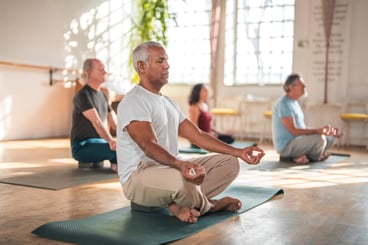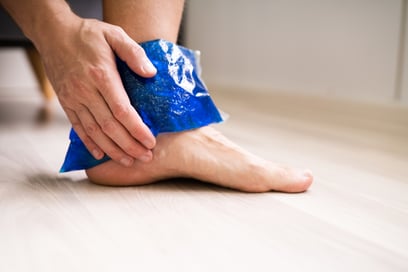 Acute and chronic pain is something almost everyone must deal with in their lifetime whether it is from an injury, overuse, or a degenerative condition such as arthritis. This consideration becomes much more common as exercisers move into the active aging portion of their fitness journey. Meditation in various forms has been shown to provide relief in both acute and chronic situations and in many cases may increase an exerciser’s overall pain tolerance. Techniques that correlate well with pain management are mindfulness meditation, body scans, visualization, guided meditation, and progressive muscle relaxation.
Acute and chronic pain is something almost everyone must deal with in their lifetime whether it is from an injury, overuse, or a degenerative condition such as arthritis. This consideration becomes much more common as exercisers move into the active aging portion of their fitness journey. Meditation in various forms has been shown to provide relief in both acute and chronic situations and in many cases may increase an exerciser’s overall pain tolerance. Techniques that correlate well with pain management are mindfulness meditation, body scans, visualization, guided meditation, and progressive muscle relaxation.
Mindfulness meditation popularized by John Cabot Zinn, PhD focuses on acknowledging the thoughts and emotions connected with pain cycles. Studies have shown that there are specific neural mechanisms at work during this type of meditation that provide analgesic benefits to the body while also triggering endorphins in the brain. Body scanning is another technique used by Zinn and others that incorporates the focus of the mind to scan the body for pain, tension, and discomfort. This technique is best done while lying comfortably on the floor or bed face up and can employ rhythmic breathing to match the pace of bodily scanning.
Guided meditations have been found to be useful in pain management with apps such as Calm and content driven websites like YouTube providing a multitude of options that range from simple spoken word to videos with intricate visuals and binaural beats audio to help reach a deeper state of relaxation and pain relief. A recent study revealed a 77% in pain reduction with the use of binaural beat technology versus the placebo. In addition, simple visualization is also an effective technique in reducing symptoms of pain, most specifically concentrating on the area in distress and focusing on healing and reduction of discomfort in the area.
Progressive relaxation is another option for pain reduction and utilizes breathwork and muscle contractions to ease pain symptoms. This technique can be performed sitting or lying down and involves beginning with the feet and lower legs being strongly contracted with an inhalation and relaxed during the exhalation. Moving all the way up the body, then back down with contractions/inhalations lasting about 5-10 seconds and the relaxation period being double the time or longer based on preference.
Starting out, a person could perform 5 minutes of meditation and slowly work up to 20 minutes a session. Also, throughout the day a ‘mini’ meditation of 30 seconds to a minute may be applied when acute pain flares up. In conclusion, different styles of meditation for self-management of pain are low risk options that are easily available and can also strengthen the mind-body connection while improving overall physical functionality.


 One of the biggest questions people have when experiencing and ache or pain is “do I use heat or ice to help eliminate my pain?” Ice and heating pads are among the most common treatments for pain, but are you using them correctly? If done wrong, using ice or heat may do more harm than good.
One of the biggest questions people have when experiencing and ache or pain is “do I use heat or ice to help eliminate my pain?” Ice and heating pads are among the most common treatments for pain, but are you using them correctly? If done wrong, using ice or heat may do more harm than good.